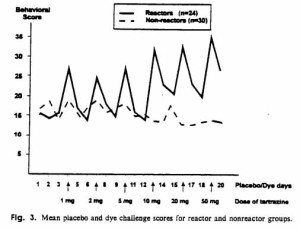 Journal of Pediatrics, November 1994, Vol. 135, pp.691-8
Journal of Pediatrics, November 1994, Vol. 135, pp.691-8
150 of 200 children [75%] improved on an open trial of a diet free of synthetic food coloring, and deteriorated upon introduction of foods containing synthetic colorings.
34 other “clear” or “suspected” reactors plus 20 “controls” were studied in a separate double blind study. 82.5% of the “suspected reactors,” 27% of the “uncertain reactors,” and 10% of the “controls” reacted to a mild single-item challenge of tartrazine (Yellow #5). The kind of reaction and length of time the children were affected depended on the dose. Parents reported that beyond hyperactivity or other core ADHD symptoms, tartrazine increased irritability, restlessness, and sleep disturbance.
QUOTE: “A dose response effect was observed.”
NOTE: Notice on the chart above (click it to enlarge), that this dose effect was obtained by using 1, 2, 5, 10, 20, and 50 mg food dye — this is quite an accomplishment and a tribute to the sensitivity of the Rowe questionnaire over the older Conners’ questionnaire for monitoring reactions.
NOTE: The 200 children who tried the 6-week diet program were drawn from a total population of 800 children who had been referred to the clinic for evaluation of possible ADHD. These were not children specifically chosen because of the likelihood to be diet-responsive.
NOTE: 10% of the controls reacted to the Yellow 5 challenge — remember, this was a group not expected to react to food dye, and not diagnosed with any disorder.
MedLine || Full Text || Get Password




















